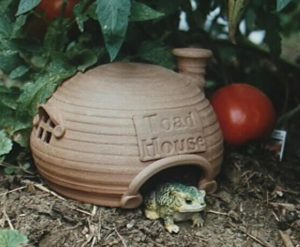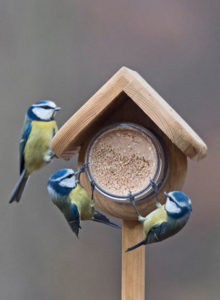Gardener’s Guide on how to Help Wildlife in the Winter
There are two types of gardeners in the world: those who want to know how to help wildlife in the winter and those who want to know how to get rid of wildlife… Period.
We gardeners often get bent out of shape when we see critters in our gardens. Bushy-tailed rabbits munching on our garden veggies; deer gobbling up the peaches from our trees; birds messily spreading seed over our yards, causing weeds and unwanted plants to bloom.
You get the gist.
And while they can sometimes be a nuisance, our gardens and yards thrive because of these critters.
A Balanced Ecosystem
Our yards are small ecosystems. Everything from the sun and the weather to the plants, animals, and microbes in your soil interact with one another and are linked by nutrient cycles. Just as we need the sun or the rain, we need animals and insects to keep our ecosystems functioning properly. All gardeners should learn how to effectively help wildlife, even if said critters are a bit creepy and crawly, because they are beneficial.
Here are a few of the critters you might see in your garden or yard and how they contribute to their ecosystem:
GARDEN SPIDERS
Has anyone ever told you not to squish a spider? While many bite and can be poisonous, a lot of spider species help control pest populations. Garden spiders will eat the insects that harm both you and your plants. If you have wasps or mosquitoes in your garden, introducing garden spiders can help reduce these insect populations, so the next time you’re out in the garden, you won’t fear being stung.
Garden spiders have black and yellow markings on their bodies, so keep your eyes peeled for these gems.
SMALL INSECTS
Some small insects, such as lady bugs, lacewings, and praying mantises, also reduce pest populations. Ladybugs and lacewings will prey on aphids, which suck the sap from plant stems, causing them to wilt and turn yellow. Praying mantises, on the other hand, will eat nearly any insect pest, so these are especially great garden critters. To attract these insects to your yard, plant herbs, such as dill and fennel, as well as cosmos, yarrow, and marigolds.
TOADS
While many shiver at the sight of a toad (no, you can’t get warts from touching a toad, silly!), these amphibians are great at controlling pest populations. Toads will eat lots of different insects, but most importantly, they will eat slugs. Slugs are incredibly harmful to gardens, as they not only devour plants, but also spread disease. Three very harmful diseases can be spread from contact with slugs–and it is not pretty.
Slugs can host rat lungworm, a parasitic nematode that infests rats’ blood vessels when hosts (such as slugs) are consumed. These nematodes will hatch eggs inside of the rat, which then crawl out of the rat’s lungs and into its mouth. If a human comes into contact with this nematode, it will travel to their brain, damaging brain tissue. You don’t have to eat slugs to to contract it, however, as eating unwashed vegetables that came into contact with infected slugs can do the trick.
Slugs also carry Angiostrongylus costaricensis, a similar disease that spreads to the intestines rather than the brain. Once inside the host, it never leaves. This disease is dangerous not only to people, but also to dogs and cats who might eat an infected slug.
Lastly, slugs can transmit salmonella to humans. If you’ve ever had food poisoning, then you get the gist.

So attracting toads to your garden is an excellent way to keep your family and your pets safe from disease. Toads like moist coverage, foliage, and water sources. Try adding a pond to your yard as a charming toad oasis or construct a few toad houses around the yard. Here’s a cute DIY tutorial for this!
PARASITIC WASPS
Now, I know, I just told you that garden spiders will eat wasps and reduce their numbers. And you liked that little bit of information. I get it. But parasitic wasps can actually be beneficial to your vegetable garden–and they often don’t sting!
Ichneumon wasps will attack cutworms, corn earworms, white grubs, and caterpillars. Braconid wasps will attack aphids, garden webworms, tomato hornworms, and armyworms. Chalcid wasps will attack cabbage worms, tomato hornworms, corn earworms, cutworms, armyworms, webworms, cabbage loopers, and corn borers.
Caution: wasps will also prey on butterfly larvae. If you have a butterfly or pollinator garden, then you might want to consider opting out for these insects.
GARTER SNAKES
Garter snakes are great garden residents because they eat crickets, grasshoppers, and other insects. If you grow lettuce, carrots, beans, corn, or onions, you might want to invite a few garter snakes over because grasshoppers love to munch on those garden veggies. Garter snakes are not poisonous, so put the shovel away and make room for these garden guests!
BIRDS
While we might think of birds as prey, they’re actually excellent predators, especially in gardens. Birds like to eat the beetles that feast on asparagus, potatoes, beans, and cucumbers. They’ll also eat cutworms and grasshoppers (so, hey, if you don’t like garter snakes, you can always rely on the birds!).
If you want to learn how to help wildlife in the winter, then keep reading. I’ve outlined a few ways you can help those garden critters!
How to Help Birds in the Winter
Birds can have a difficult time finding food in the winter when insects are hibernating. While they may look fluffy and fat this time of year, they’re actually just ruffling their feathers to stay warm. If you want to keep your garden birds safe and fed so they’ll stick around in the spring, follow these tips:
Keep them Warm and Safe
Providing bird houses is a great way to keep birds warm and safe from predators. If you like DIY projects, here’s a great list of DIY birdhouse ideas.
If you don’t like DIY projects then head over to your local store and buy a few birdhouses. Remember to add dry grass or wood shavings to keep the birds warm. We’ve found that birds will also use cat hair as insulation, so if you’ve just brushed Fluffy, put his hair in the birdhouse to add some warmth.
Provide Smart Water Sources
Birds need to drink, but this is often something we don’t think about.
When it snows outside, the birds will often eat the snow as a way to stay hydrated. But when temperatures are below freezing and there’s no snow, the birds have no way of staying hydrated. A good idea is to maintain a heated water bath.
It is important, however, to make sure the birds do no more than drink the water. If they bathe in the bath and then fly off, the water can freeze to their feathers. Add some rocks to the birdbath to keep them from sitting in the water.
Feed Them
Add several bird feeders to your yard to keep the birds fed. Make sure you add seed periodically, but don’t add too much at a time. If it rains or snows and the seed gets wet, the birds won’t eat it.
It’s also a good idea to position windbreakers near your bird feeders to keep them safe from wind and heavy snowfall that could potentially blanket them. Trees, plywood, and brush-piles work well for this.

Sometimes, people ask me what to feed birds in the winter and if their diets change during the cold season. It’s important to provide birds with high energy foods in cold weather, so mix up your menu. Complement your birdseed with some peanut butter. And if you’re feeling festive, make birdseed ornaments to hang on your fir trees.
How to Help Insects in the Winter
Birds aren’t the only ones who need help in the winter. In fact, a lot of the choices you make in the month leading up to winter weather can make a difference in these critters’ lives.
Many overwintering insects hibernate in the things we like to burn or toss out. Fallen leaves, for instance, make great beds for spiders, salamanders, butterflies, and caterpillars. Gather decomposed materials, such as leaves and pine needles, and pile them in a shaded spot. You can cover them with burlap to keep the soil beneath from freezing.
Instead of clearing away dead plants and debris from your garden, keep them in a shaded, safe place for overwintering insects. As a good rule of thumb, keep the following and clear the rest:
- Bark
- Dried Leaves
- Dead Plants/Flowers
- Grasses
- Rocks
- Hollow Logs
If something is diseased, however, you should certainly get rid of it.
Keeping these items in your yard will keep bees, butterflies, hoverflies, ladybugs, wasps, ants, and midges safe in the winter. It’s important to keep these insects safe because they pollinate the plants we love.
Saving Lives Year-Round
When the last of that winter snow melts and everything bursts to life again, remember that these critters are essential to your garden’s health. We want to help them in the winter, and we should want to help them in the spring and summer too.
Limit or end your use of pesticides. By introducing the natural predators listed above, your garden won’t need pesticides. Besides, just because you target one type of insect with a chemical, it doesn’t mean you won’t end up killing more than your intended target.
And remember what I said earlier about ecosystems and how everything has a role? Well, we should keep in mind that soil is a living organism and that its role in our gardens could not be more important. Soil provides a habitat for animals, insects, bacteria, and fungi. It also recycles nutrients and absorbs gases and water. Keeping the soil healthy will reduce the chances of erosion and ensure that you can grow healthy crops in your garden.
So how exactly do you keep soil healthy?
First, don’t till your soil unless it is required for the plants you grow. Tilling will destroy soil aggregation and fungal communities, add excess oxygen to the soil, increase soil erosion and carbon loss, and cause an increase in water runoff and soil loss.
In addition, you should put careful thought into the type of fertilizer you use on your garden. Fertilizers can affect soil pH, acidity and salinity levels, and water absorption rates. This, consequently, affects your plants as well.
xVital, our nitrate water solution, combines ionized water with nitrate to form a natural plant food that does not negatively impact soil or the environment. Because it has no chemicals or salts, it doesn’t harm the soil or plants’ roots. In addition, xVital produces no runoff, so it doesn’t hurt the environment.
Check out xVital today to keep your garden’s ecosystem perfectly balanced.
Sources:











